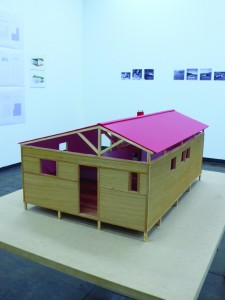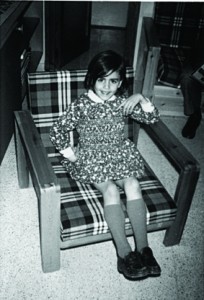A Summerhouse
Interview with Martí Ansón by Juan Canela
Northern designs into a southern cooperative scenario:
a conversation between artist Martí Ansón and curator Juan Canela

Martí Anson, Summer House in Paris – Catalan
Pavilion – Anonymous Architect, 2013
Installation view at Palais de Tokyo, Paris
Courtesy of the artist
and Estrany-de la Mota Gallery, Barcelona
Juan Canela: Martí, in your last project, Catalan Pavilion – Anonymous Architect, which is now being shown at Palais de Tokyo, you reconstruct a vacation house built up by your father during the 1970s in Catalan Pre-Pyrenees; could you tell a little about it?
Martí Ansón: The idea is trying to rebuild, during the weekends prior to the opening, the holiday house that my father put up on a 1/1 scale in the exhibition space. Maybe it will be finished, or probably not, due to timing and budget issues, but this is part of the project.
The project’s starting point is the house of a person who isn’t an architect but built a home by following certain principles of austerity of those times: simple, functional and absolutely practical construction; exterior does not matter and interior is just the minimum for six people, making the maximum of the available space. Without knowing it, my father was re-using French and German architects’ rules: a house must be functional, no doors to expedite space … but on the other hand, the kitchen and living room take up 1960s Catalan architecture principles from José Antonio Coderch, who unified tradition and modernity. Northern European architects such as Alvar Aalto also influenced Coderch. This fact was quickly translated into political acts of resistance to the Franco dictatorship’s structures, since it proposes a functional architecture opposed to the dominant mode of the moment. However there’s a very important difference from northern European trends: architecture is made from tradition without losing its origins, so there’s a combination of northern elements (such as large windows) and local materials (floor tiling or stone walls), embellishing buildings with poor materials. They take northern designs without losing the traditions of the South, without losing local identity. This is the idea that my father had.
JC: Why do you add the term “pavilion” to the title?
MA: In order to give an interpretation that exceeds the personal and takes it to a universal level. A pavilion has a political aspect related to the architecture of place and time represented. By naming it the Catalan Pavilion I am playing with humour and the absurd in order to provide this political character. Besides, the fact that it is detachable and that it probably won’t be finished at all, is inserted into this layer of meaning. On the other hand, the uncertainty of how far I will be able to build, the fact that the project exceeds myself, is something that interests me more and more everyday.
JC: The fact that it is a house located away from the city, built up in a recondite part of Catalan Pre-Pyrenees, is connected to some of the theories of GATEPAC, a group of pioneer architects who worked during the second Spanish Republic…
MA: Exactly. Somehow they promoted going out of the city and they saw the holiday house as a place to escape from all urban problems. Besides, just as in the one I’m building at Palais de Tokyo, those GATEPAC holiday houses were detachable, so you could build them during summer and dissemble them afterwards.
We can also draw a parallel with Heidegger’s Black Forest house: a retreat for thought, without distractions, away from visitors, merged with the surroundings and similar to the houses around. In my father’s case the house was intended for leisure and rest, but it was also far from the city and it resembled all the other houses in the area.
On the other hand, what interests me above all is how someone who doesn’t have any architectural studies gets to build a totally functional house for his family. This happens because certain dynamics of collaboration existed in Spain at that time, by which each person contributed with their knowledge for the greater good: lawyers, doctors, architects … each contributed their skills. In this environment, my father had a skill to articulate spaces and got into this cooperative context.
JC: This takes us to your previous project, Joaquimandson, where you reproduce and commercialise furniture made by your father during the 1970s. How does this will to work on these particular aspects of your family history arise?
MA: The interest starts from the intuition that through these little personal and collective facts society and identity are constructed, and perhaps it’s time to notice them.
The origin of Palais de Tokyo pavilion is actually the end of making this furniture. Without furniture, the pavilion wouldn’t have existed. The starting point for the furniture is my father’s skill in designing spaces and his collaboration with the architects of the cooperative. Manuel Brullet, another architect from that time, talked about “architecture of use” and “architecture of capital”, and here we are talking of course of the architecture of use, created exclusively to live properly, not to make profit. Anyhow, the architecture of capital is the one that finally ended up succeeding after the fall of the dictatorship and the Spanish real estate boom. My father created furniture for use: he discussed with families their needs and budget and then adapted the furniture, without business intentions.
It happens that all these cooperative dynamics initiated by need quickly gain political dimensions, as a breach with established regimens and as a search for a new world to live in. The furniture comes from this context—if it had not been part of this scenario, it would have stayed at my father’s house. But instead, many families from Barcelona and nearby enjoyed the functional aspect of the furniture. During the 1970s, when he tried to set up a business with a partner, he did not feel right and quit. Without personal bonding, the project did not work.
JC: In fact, you introduce something that really gets my attention and that I consider one of the most powerful aspects of these projects: Reflecting on the actions of your father, you talk about the dynamics related to the idea of the cooperative that resulted from altruism without any commercial interests during those years in Spain. Some places, such as Cataluña, have been pioneers in this sense. The years of the second Spanish Republic was the climax of these structures, along with laws replicated all over America and Europe. During the dictatorship all this disappeared and the little gestures left accomplished great thing, as you say, but ended up vanishing when democracy and capitalism arrived.
MA: Yes, dictatorship became a common front for many people of different ideologies but they started to manifest their discrepancies with the democracy arrival.
JC: And perhaps with Spain’s opening up in the 1970s and capitalism reaching the country, all these initiatives end up becoming a business or are institutionalized and lose their essence.
MA: Yes, it’s just as when my father set up that store with his partner and they eventually did not agree each other. They had started to mass produce furniture and this was against the initial idiosyncrasies. Once business is the objective, personal matter, which was one of my father’s project bases, is lost—so he quit.
JC: We cannot help noticing that all these cooperative movements and initiatives are emerging again.
MA: Yes, but it is more difficult now, for a simple reason: at that time, the preceding years were worse. Now it’s the opposite—we come from a better period of economic splendour and we find a crisis scenario. A different scheme makes behaviour more complicated…
JC: True, the contexts are not alike, but in both cases it is the result of a need, and that need forces people to organise themselves for the common good.
MA: There’s another aspect to understand differences between these two periods and that is the excessive regularisation of our time. Laws exist for everything. Even to make furniture you must go through several checks; today my father could have not done the house as he did, without an architect signing off the work. This impairs autonomous and cooperative dynamics, but doesn’t mean that they aren’t rising each day.
JC: The 1960s and 1970s were still years when Franco tried to prevent the country from reaching modernity and culture, so architecture or design trends were reached through alternative channels to be then adapted to local ways…
MA: In fact, the act of adapting and customising whatever came from abroad becomes political even if it is unconsciously. During that period, any small gesture that broke the established rules stood up for local identity and meant dictatorship disapproval. In this sense, making furniture by re-adapting northern design and personally selling it though family cooperatives was a political action.
Starting from there, many citizens’ groups agree on several matters and create autonomous ways of functioning and living. For example, in Mataró (my hometown) those who didn’t want their children attending religious schools related to the Franco dictatorship created their own, which again becomes a tremendously political act, even though they surely didn’t notice that, but were simply looking for a way to educate their children in their own ways.
It can be fun to compare what it is happening today with, for example, Ikea: when I was little and I went to my friends’ houses (whom I met at the school my parent had created) we all had the same furniture—used in different ways and adapted, but basically the same style. It was a small area, let’s say 180 apartments in Mataró, 80 in Barcelona and a few in Tarragona, but even though it is referred to as “Anson Furniture”, like a brand, it was not meant like that then.
JC: Nevertheless, the conception was totally the opposite to Ikea’s objective of mass-producing identical furniture and distributing it around the world…
MA: Yes, but I think Ikea started around the same years as my father… Meaning that if he had continued his business maybe today there would be an Ikea originated at Mataró. But in the beginning it was different, it was “do it yourself” in functional and economical ways. If a family had 10,000 pesetas, furnishing was made in a way that prioritised its function.
Martí Ansón is an artist working and living in Mataró (Barcelona), Spain.
Juan Canela is a curator working and living in Barcelona, Spain.















